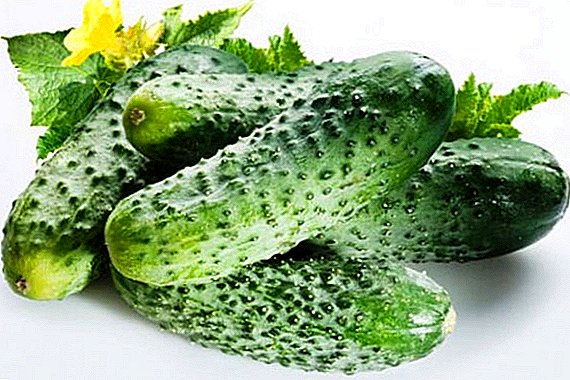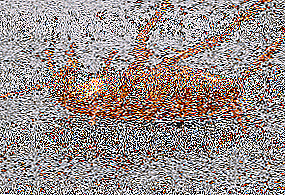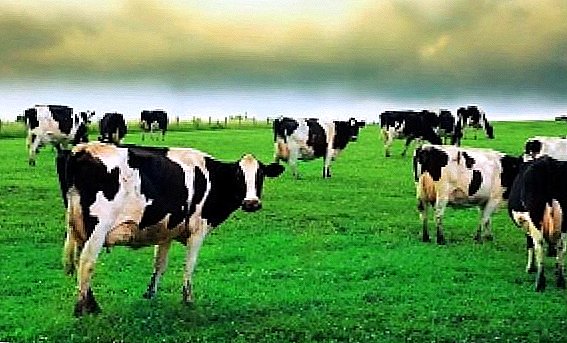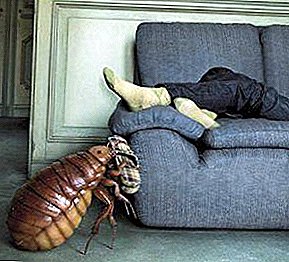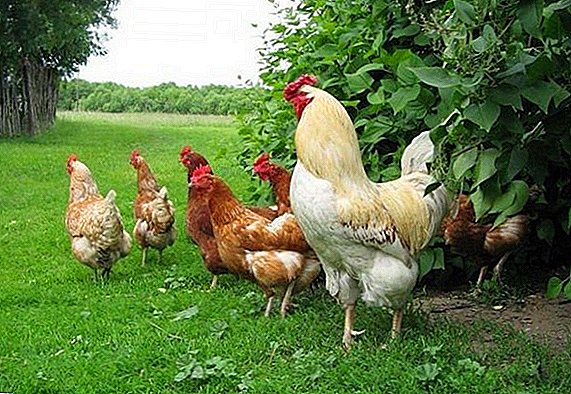 Unfortunately, poultry often suffers from various diseases that are divided into specific groups: infectious, non-infectious, parasitic, and dangerous to humans.
Unfortunately, poultry often suffers from various diseases that are divided into specific groups: infectious, non-infectious, parasitic, and dangerous to humans.
In our article we will tell in detail about each group, about the symptoms of diseases and methods of treatment.
Infectious diseases of chickens
This group of diseases requires timely and thorough diagnosis. It is very important to understand that the disease can be transmitted to other animals and humans, so you need to immediately identify it and take action. We offer to familiarize with some infectious diseases of birds.
Gumboro disease (infectious bursal disease)
The disease is a dangerous viral infection that affects young animals up to 20 weeks. As a result, immunity decreases and death often occurs.  Main symptoms:
Main symptoms:
- this ailment has no pronounced symptoms;
- diarrhea and cloaca can sometimes occur;
- temperature stays at a normal level, occasionally decreases.
Important! In order to prevent the occurrence and development of ailments, it is worthwhile to periodically inspect the bird and identify visible symptoms.
Treatment methods
Currently, there are no methods and means to combat the disease, and the diagnosis can only be made after the death of animals. Dead birds should be buried deep, buried with lime or burned.
Preventive measures
It is necessary to follow sanitary rules and conduct quarantine for birds that have just been bought.
Newcastle disease
In this disease, the nervous system, respiratory organs and the digestive tract of the bird suffer. The source of infection can be food, water, individuals that have recently been ill, litter. The transmission path of the virus is airborne.  Main symptoms:
Main symptoms:
- temperature rise;
- drowsy condition of the bird;
- mucus builds up in the mouth and nasal cavity;
- there is a trembling of the head, movement of the bird in a circle;
- there is a lack of coordination of movement, the birds fall on their side, throw their heads;
- no swallowing reflex;
- the crest becomes bluish.
Treatment methods
Nowadays there are no treatments for this disease. Fall of birds occurs on the 3rd day, sometimes reaches 100%. As soon as the diagnosis is made, it is necessary to destroy all livestock.
Preventive measures
It is very important to observe sanitary rules, as well as to vaccinate animals. There are several types of vaccine: live, weakened in the laboratory, live, natural, weakened, inactivated.
Enter drugs aerosol, enteric or intranasal route. Dead birds are buried deep, buried with quicklime or burned.
Marek's disease
The disease occurs in chickens quite often. The virus suffers from the nervous system, eyes, painful tumors appear on the skin, in some organs.  Main symptoms:
Main symptoms:
- appetite decreases, the body is depleted;
- there is a change in the iris;
- there is a gradual contraction of the pupil, sometimes the bird completely blind;
- discoloration of scallops, earrings, and mucous membranes is observed;
- the bird moves with difficulty;
- goiter paralysis occurs.
Treatment methods
When the first symptoms appear, it is necessary to establish an accurate diagnosis as soon as possible. This disease can not be cured. A bird that has been infected is killed.
Preventive measures
The only way to protect animals from the disease is to vaccinate young animals at the age of 1 day. If you buy birds, be sure to ask the seller a document that the animals have already been vaccinated.
Learn more about what diseases are laying hens in winter, what are the diseases of the legs and eyes in chickens.
Coccidosis (bloody diarrhea)
The causative agent of this disease are coccidia. Most often, the parasite attacks young animals under the age of 3 months, as the adults are immune. Damage occurs to the kidneys, intestines, and sometimes the liver. After recovery, the bird is the carrier of the parasite for 7-8 months.  Main symptoms:
Main symptoms:
- apathy, depressed state of the bird;
- animals do not get off the perch;
- loss of appetite is observed, the body is depleted;
- diarrhea begins, the feces are green, with mucus and blood;
- scallop, catkins and mucous pale;
- the wings of the bird go down, there is a ruffled feathers;
- animals hardly move and move.
Treatment methods
For therapeutic purposes, the use of furagin, norsulfazole, sulfadimezin, zolen is recommended. Medicines must be mixed with food or dissolved in water. Therapeutic and prophylactic course lasts 5-7 days.
Preventive measures
Measures should be taken regularly to disinfect poultry houses and equipment. This can be done using soda solution. It is necessary to perform a thorough treatment of the floor, walls, feeders and drinkers using a blowtorch.
Colibacteriosis
As a result of this disease, most of the internal organs of the living creatures E.coli are affected. Mark the acute course of the disease in young and chronic forms in adult birds.  Main symptoms:
Main symptoms:
- appetite deteriorates, great thirst arises;
- chickens become lethargic, indifferent;
- there is an increase in body temperature;
- chickens breathe heavily, wheezing;
- peritoneum may be inflamed, gastrointestinal disorders occur.
Treatment methods
The treatment is carried out with the use of antibiotics. Terramycin or biomitsin must be mixed with food (100 mg per 1 kg). In addition, sulfadimezin is used as an aerosol.
Preventive measures
It is necessary to carefully comply with sanitary and hygienic standards. The diet of poultry should contain fresh and balanced feed.
Laryngotracheitis
Laryngotracheitis is an acute infectious disease that affects all poultry. When it irritates and inflames the mucous membrane of the larynx and trachea, conjunctivitis may occur.  Transmission of the virus is carried out by airborne droplets. Poultry, which had been ill, for 2-3 years is a carrier of viral ailment, but becomes immune.
Transmission of the virus is carried out by airborne droplets. Poultry, which had been ill, for 2-3 years is a carrier of viral ailment, but becomes immune.
Did you know? The number of domestic chickens exceeds the population of our planet by 3 times.Main symptoms:
- the presence of wheezing, shortness of breath;
- inflammation of the mucous membranes of the body;
- reduced egg production;
- vision problems.
If a running form is diagnosed, the therapy will not be effective. At the initial stage of laryngotracheitis the bird is given thromexin, which is dissolved in water (2 g per 1 l). Starting from the second day, the dosage is reduced to 1 g per 1 liter of water. The course of treatment is at least 5 days and lasts until recovery.
Preventive measures
It is important to strictly observe sanitary standards and organize quarantine for individuals that have just been bought. Vaccination is also recommended.
Mycoplasmosis
Mycoplasmosis is a chronic respiratory disease that all poultry is exposed to. The causative agent of the disease is mycoplasma.  Main symptoms:
Main symptoms:
- the presence of difficulty breathing, coughing;
- nasal discharge of mucus and fluid;
- inflammation and redness of the eyes;
- Gastrointestinal disorders.
Treatment methods
If the last stage of the disease is diagnosed, the destruction of sick chickens is recommended. If the disease is at the initial stage, therapy is carried out with antibiotics. Oxytetracycline should be added to food for 7 days (0.4 g per 1 kg of feed). Then make a break for 3 days and repeat the course.
Preventive measures
Chickens at the age of 2-3 days should be given a solution of titan within three days. Every 6-7 weeks the prophylactic course is repeated. In addition, it is necessary to ensure good ventilation in the house.
Smallpox
With this ailment, pockmarks begin to appear on the skin, white secretions appear on the mucous membranes.  Main symptoms:
Main symptoms:
- the bird becomes weak, exhausted;
- swallows with difficulty;
- breath has an unpleasant smell;
- red spots appear on the skin;
- the skin is covered with scabs.
Treatment methods
Therapy can be effective if the disease is detected at the initial stage. The areas that were affected must be treated with a furacilin solution or boric acid. Simultaneously with the feed, it is necessary to give the bird biomotion within 7 days.
However, in most cases, veterinarians recommend to kill sick chickens so that the disease does not spread to other animals.
Preventive measures
It is necessary to comply with sanitary and hygienic norms and rules, regularly carry out cleaning and disinfection of the chicken coop and equipment.
Pasteurellosis
The illness can have an acute and chronic form. The causative agent is Pasteurella, which is able to maintain viability in water, manure and food.  Main symptoms:
Main symptoms:
- in chickens, lethargy, depression, and immobility are observed;
- body temperature rises;
- loss of appetite and great thirst;
- diarrhea may begin;
- faeces have a liquid consistency, green color, mixed with blood;
- it is difficult for the bird to breathe;
- earrings and ridges get bluish color;
- paw joints swell and bend.
Important! When the first symptoms of the disease appear, even if the diagnosis has not yet been established, the affected chicken should be isolated from the entire herd so that the rest of the birds do not become infected.
Treatment methods
For therapy use sulfa drugs. They must be added to water. In addition, greens and vitamins should be present in the poultry diet.
Preventive measures
In order to prevent the development of this disease, it is important to destroy all rodents and prevent their access to food. Egg disinfection must be performed before incubation. Despite the fact that there are drugs against this disease, veterinarians recommend to kill animal life.
Pullorosis
This disease has another name - typhus. Transmission of bacteria occurs through airborne droplets. It is worth noting that eggs from chickens suffering from typhoid fever are also infected. Initially, the disease is acute and gradually becomes chronic.  Main symptoms:
Main symptoms:
- the bird is lethargy, inactivity;
- there is no appetite, and the living creature is thirsty;
- feces have a liquid consistency, yellow color;
- chickens often breathe;
- there is a strong weakness in chickens and a strong depletion in adults.
Treatment methods
In order to establish an accurate diagnosis, a biological preparation that contains a pullor antigen is necessary. As soon as the first signs of the disease appeared, the sick bird should be immediately isolated and started treatment with antibiotics.
For this purpose, biomitsin is used. In addition, it is recommended to add furazolidone to the food of a healthy bird.
Preventive measures
It is important to regularly disinfect the chicken coop, and in the presence of a sick individual immediately remove it from the herd.
Salmonellosis
It has an acute or chronic form. In most cases, the disease affects the young. The disease is transmitted as a result of contacting sick and healthy birds.  Main symptoms:
Main symptoms:
- poultry sluggish, weak;
- feathered breathe heavily;
- there is a lowering and bonding of the eyelids;
- appetite worsens and thirst increases;
- there is diarrhea;
- leg joints swell up;
- inflammation of mucous cloaca occurs.
Treatment methods
The treatment is that individuals are given furazolidone for 20 days. It must be dissolved in water (1 tablet per 3 liters). It is also worth giving streptomycion twice a day for 10 days. Then you should take a break for 7 days and re-take a therapeutic course.
Preventive measures
In order to prevent the need for vaccination of healthy individuals with immune serum. After the therapy is completed, the house and equipment must be disinfected. A bird that has had it is a carrier, so if possible, it is better to kill it.
Tuberculosis
When the disease occurs, the defeat of the lungs, and in some cases, all the internal organs. Tuberculosis occurs due to non-observance of hygienic norms.  Main symptoms:
Main symptoms:
- the bird moves poorly;
- chickens lose weight;
- no laying;
- dark scallop.
Tuberculosis is not treatable, so infected chickens are killed.
Preventive measures
It is often necessary to carry out cleaning in the house, adhere to sanitary and hygienic norms and rules.
Get acquainted in more detail with the symptoms and methods of treatment of the above infectious diseases: Gumboro disease, Newcastle, Marek, salmonellosis, pullorosis, mycoplasmosis, laryngotracheitis, colibacteriosis, tuberculosis.
Non-contagious diseases of chickens
There is another group of diseases of chickens - it is non-communicable diseases. We suggest to get acquainted with the most common of them.
Avitaminosis
Occur when there is a lack of any vitamins in the body of the bird. It affects all birds, regardless of age, but youngsters under the age of 3 weeks suffer the disease especially hard.  Main symptoms:
Main symptoms:
- body weight is reduced;
- comb and earrings get a white tint;
- the hen becomes weak, oppressed, convulsions appear;
- appetite worse;
- there are problems with the coordination of movements;
- egg production rates are reduced;
- there are disorders of the gastrointestinal tract;
- conjunctivitis may occur;
- peeling and irritation appear on the skin.
Treatment methods
Therapy for beriberi is quite simple - you need to add to the poultry diet those vitamins, the lack of which was identified.
Preventive measures
In order to avoid vitamin deficiency, various adapted multivitamins should be added to the food of birds.
Arthritis
Most often the disease occurs in broiler chickens. One of the clear signs of arthritis is that inflammation of the articular sac occurs, leading to chickens falling on their legs.  Main symptoms:
Main symptoms:
- the bird limps;
- an increase in joints occurs;
- there is a rise in temperature;
- swelling on the legs prevents movement of the feathered, so they are always in one place.
Treatment methods
For therapy using such antibiotics and antiviral drugs:
- "Sulfadimethoxine";
- "Polymyxin M Sulphate";
- "Ampicillin";
- "Benzylpenicillin".
Injections are made to the bird for 5 days or mix the medicine with food.
Preventive measures
It is necessary to perform a thorough cleaning in the hen house, make sure that the chickens do not curl.
Atonia goiter
The occurrence of the disease in most cases depends on the quality of the feed. As a result of atony, the goiter overflows with food, and as a result, the patency of the esophagus decreases.  Main symptoms:
Main symptoms:
- the bird refuses to eat, becomes oppressed;
- to the touch goiter is very dense, sags;
- shortness of breath appears, weight loss occurs;
- asphyxiation and death may occur.
Treatment methods
In order to free the goiter from the food stuck in it, it is necessary to introduce several droplets of sunflower oil through the beak. Then, gently massaging, gently squeeze the mass through the beak.
If such a procedure is not possible, you should contact a veterinarian who will remove the masses with the help of surgical intervention.
Preventive measures
It is necessary to ensure that the bird does not have a long hunger strike, and before giving the legumes, it is recommended to steam them for 60 minutes.
Bronchopneumonia
Most often young people under the age of 20 weeks suffer from bronchopneumonia. The risk of disease increases with hypothermia birds.  Main symptoms:
Main symptoms:
- the mobility of young animals is reduced;
- mucus comes out of the nose and catches the breath;
- wheezing during breathing;
- there is a loss of appetite.
Did you know? The weight of the largest chicken egg, which is listed in the Guinness Book of Records is 170 g.Treatment methods
Therapy is carried out using penicillin, terramycin and other antibiotics. It is important to stick with the dosage that the vet will prescribe.
Preventive measures
It is very important to observe the temperature regime in the house. Until the chicks reach 3 weeks of age, they should not be placed tightly.
Gastroenteritis
Disease can occur due to poor quality grains, salts and metals.  Main symptoms:
Main symptoms:
- the bird becomes depressed, weak;
- feces acquires a liquid consistency, yellow-green color and unpleasant odor;
- appetite decreases;
- body temperature rises.
Treatment methods
First of all, it is necessary to eliminate the causes that caused the disease. The bird must be transferred to a half-starved diet, which will include easily digestible substances and vitamins. In addition, laxatives can be used to clean the intestines.
Preventive measures
Disinfection should be carried out regularly in the house, cleaning of the trough and feeders should be carried out. Let's feathery high quality food and protect your pets from stress.
Learn how to properly disinfect the chicken coop.
Dyspepsia
In most cases, dyspepsia is susceptible to youngsters under the age of 3 weeks, because the menu is too early to introduce coarse, poorly fed and difficult to digest food.  Main symptoms:
Main symptoms:
- the bird is weak, sedentary;
- loss of appetite;
- the abdomen becomes hard as it is filled with gas;
- feces acquires a liquid consistency;
- body temperature rises;
- intoxication occurs;
- convulsions appear.
Treatment methods
The first step is to provide a feathered diet. In the diet should be easily digestible feed. Water should be replaced with a weak disinfectant solution of soda or potassium permanganate. If there are symptoms of intoxication, it is necessary to undergo a course of treatment using antibiotics and sulfa drugs.
Important! It is forbidden to eat eggs from chickens with salmonellosis, as the disease is transmitted to humans.
Preventive measures
It is necessary to conduct regular sanitization of the hen house and inventory, to keep the feeders and drinkers clean. In addition, it is important to provide animals with high-quality high-quality food.
Keratoconjunctivitis
When keratoconjunctivitis appears inflammation of the mucous membranes of the eyes, with the release of pus. If there is no therapy, the animal will be blind. Most often the disease occurs when inhalation of ammonia by the living creatures.  Main symptoms:
Main symptoms:
- depression, immobility of birds;
- eyelids swell and stick together.
Treatment methods
At least three times a day, you should rinse your eyes with an antiseptic solution, lubricate with ointment with corticosteroids.
Preventive measures
It is necessary to constantly monitor the livestock and adhere to sanitary standards.
Cloacite
Most often the disease can manifest itself if there is a lack of phosphorus salts and vitamins in the feed. In most cases, layers suffer from cloacitis.  Main symptoms:
Main symptoms:
- gastrointestinal disorders;
- the mucous membrane of the cloaca is inflamed;
- hemorrhagic ulcers occur;
- reduced weight of birds;
- masonry stops.
Treatment methods
It is mandatory to isolate sick chicken. The inflamed cloacal mucosa is washed with a solution of rivanol, after which it must be oiled with an ointment that can be prepared independently (200 g of vaseline, 1 g of terramycin and 1 g of anesthesin).
Preventive measures
Disinfection should be carried out regularly. The poultry diet should include vitamin flour, alfalfa, vitamins and mineral supplements.
Diseases caused by the pathogenic activity of worms and parasites
Consider the most common diseases of this group.
Worms
Worms are internal parasites that are fed by their host.  Main symptoms:
Main symptoms:
- decreased appetite;
- Gastrointestinal disorders appear;
- chickens lose weight;
- animals become lethargic and weak.
Treatment methods
If the worms are found in at least one chicken, therapy is carried out for the entire herd. It is necessary to contact a veterinarian who will prescribe an anthelmintic drug and tell you what dosage to use.
Preventive measures
Disinfection of the hen house and inventory should be carried out. It is necessary to control that chickens are not in contact with wild animals.
Pliers
The most common parasite is the feather mite, which settles in the blood and destroys the stem of feathers.  Main symptoms
Main symptoms
- birds partially or completely lose their plumage.
Treatment methods
To date, there are no effective methods of treatment, therefore, the infected bird is killed.
Learn how to get rid of ticks from chickens.
Preventive measures
It is necessary to strictly observe sanitary rules and place only purchased livestock in quarantine.
Feather and peroedy
Identify the presence of these parasites can be when considering feathers.  Main symptoms:
Main symptoms:
- chickens are restless;
- the living creatures itch;
- holes appear on feathers.
Treatment methods
Therapy is carried out with the use of insecticide drugs "Insektol" and "Arpalit". Feathers must be processed at a distance of 20 cm. It is important that the medicine does not fall into the eyes and beak.
Preventive measures
Twice a month it is necessary to carry out prophylactic treatment with drugs intended for therapy.
Ringworm
Ringworm is a rather dangerous fungal disease that can lead to the death of birds.  Main symptoms:
Main symptoms:
- the appearance of yellow formations on the scallop and catkins;
- labored breathing;
- feathers fall out;
- body weight is reduced;
- fecal liquid.
Treatment methods
The disease is incurable, therefore it is recommended to kill the bird.
Learn how to get rid of peroedol chickens.
Preventive measures
It is important to provide the animals with good nutrition and clean maintenance.
Diseases of chickens, dangerous to humans
There are diseases that can be transmitted to humans.  These include:
These include:
- pullorosis;
- pasteurellosis;
- salmonellosis;
- colibacteriosis;
- Newcastle disease;
- bird flu.
Did you know? An interesting monument is set in Stockholm - the chicken that runs across the road. The sculpture is comic and symbolizes a modern woman who is always in a hurry somewhere.
Unfortunately, poultry is often exposed to various diseases, so it is very important to know how to prevent and treat them. Observing cleanliness in the hen house and complying with sanitary and hygienic standards, many ailments can be avoided.


